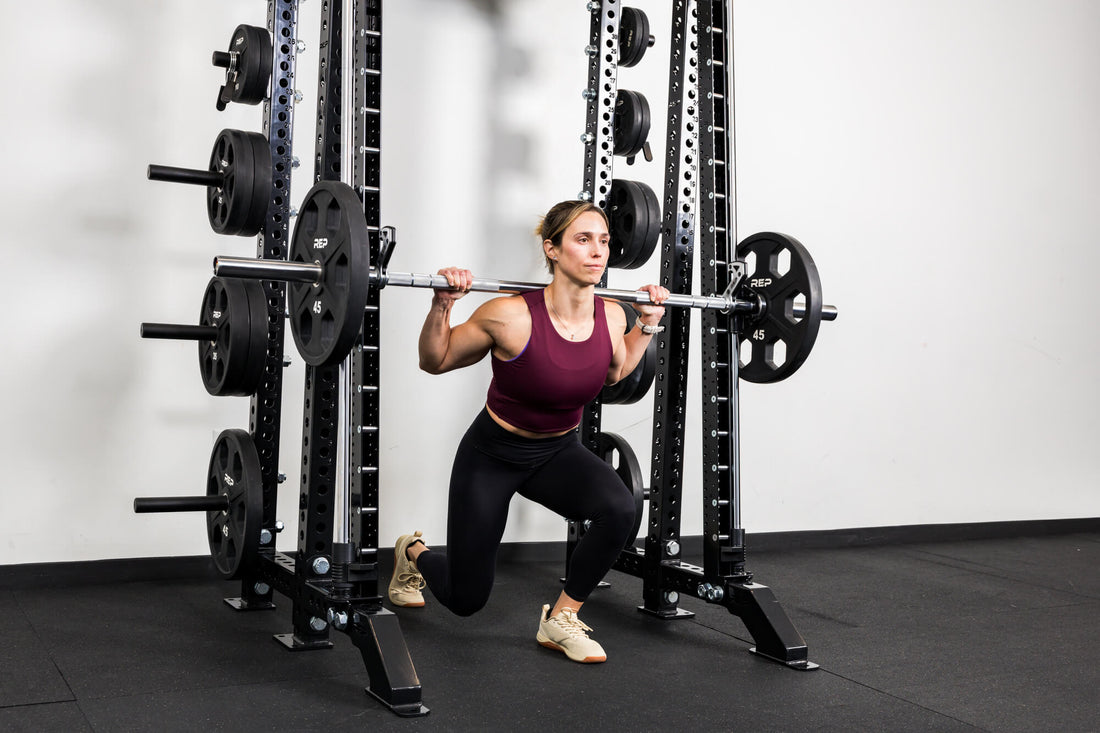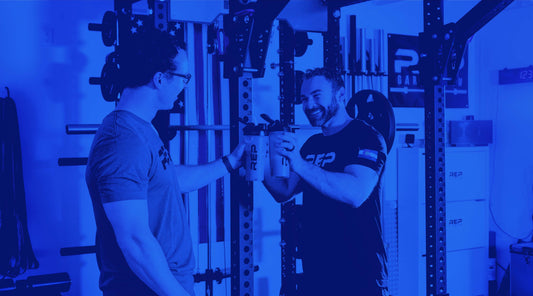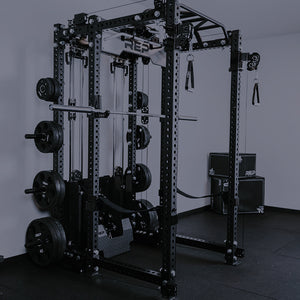
Your knees will thank you.
Every good leg workout needs a unilateral movement. The Smith machine lunge is a too-often-overlooked exercise that deserves to be your go-to for building muscle and strength. Here’s why, how to do it properly, and the mistakes to avoid.
What Are Smith Machine Lunges?
Let’s address the elephant in the room:
You can’t actually do lunges using the Smith machine. Most stations have a fixed bar that can only move up and down, not travel forward in space. What we’re talking about here is a form of split squat, where your legs are staggered and you work one limb at a time—a must-have on leg day.
Technicalities aside, Smith machine lunges are a fantastic and oft-overlooked option for unilateral leg training, regardless of your fitness goals.
Sure, they won’t help you hit your step count, but they’re still worth doing. Here’s why.
What Muscles Do Smith Machine Lunges Work?
The Smith machine lunge works many of the muscles you rely on for other leg exercises like free-weight squats or the leg press. Here’s a rundown of the three major areas you’ll target:
- Glutes
-
Quads
- Core
It’s worth noting—squat variations, whether on one leg or two, are not the best exercises for the hamstrings. Your hammies are biarticular; they cross two joints, your knee and hip.
When you squat, the hamstrings stretch out at one end and contract at the other, giving them poor leverage to generate force or bear mechanical tension. You can adjust hamstring activation with your stance, but expect this movement to be quad- and glute-focused.
How To Do Smith Machine Lunges: Step-by-Step
Here’s a brief rundown of the correct way to perform Smith machine lunges. For this exercise, all you’ll need is the machine itself. We’ll talk helpful equipment later on.
-
Set the Smith bar at around chest height and step under it with a staggered stance; back foot behind you, working leg about two feet in front.
-
Rest the bar on your upper back and hold it lightly with both hands.
-
Push up against the bar and twist it to unlock it from the safeties, then get situated with most of your weight on your front leg.
-
Slowly sink into a lunge position, dropping your hips down toward the floor until your front-leg thigh is approximately parallel to the ground.
-
Push into the floor with your front leg and return to the starting position—perform all your reps with one leg, then switch sides.
An essential tip: Your back leg works like the kickstand on a bicycle. Use it for balance and stability, but let your front leg do most of the work. Your back knee should bend and almost touch the floor, and remember to let your back heel come up.
Smith Machine vs. Free Weight Lunges
What you need to know: Smith machine lunges aren’t lunges in the traditional sense, but they work all the same. Most trainers consider the defining feature of a lunge to be forward motion, which you can’t do at a Smith station.
When it comes to free weight (dumbbells, kettlebells, a barbell, or a sandbag) vs. Smith machine lunges, think of it like this:
-
Smith machine lunges are more stable and easier for most beginners, but may feel awkward and incompatible with your body type.
-
Free weight lunges are more dynamic, tax your cardiovascular system harder, and let your body move more naturally.
When To Do Each
If you’re trying to focus solely on building muscle, increasing maximal strength, or have poor balance, you’ll probably fare better with the Smith machine.
If you want a challenging workout on leg day that stimulates both your skeletal muscles and heart, and have the means to perform them, free weight lunges work wonders.
Benefits of Smith Machine Lunges
From athletic trainers to bodybuilding coaches, strength training pros revere single-leg training. Unilateral exercises like the Smith machine lunge live up to the hype, too—studies repeatedly show that single-leg training affords unique benefits like:
-
Improving sport-specific performance, especially in contexts where you spend a lot of time on one foot.
-
Evening out side-to-side imbalances in strength or stability.
-
Bolstering real-world core strength, especially anti-rotational capabilities
Beyond the scientific, we can’t overlook the practical utility of Smith machine lunges. Free weight lunges require sufficient open space, and can be awkward in a crowded gym.
Balance is a factor as well. The fixed bar in the Smith machine lessens the stability requirement while not removing it altogether, so you can reap the proprioceptive benefits while also pushing yourself.
Common Mistakes to Avoid
Most of the errors that plague Smith machine exercises occur before you’re actually doing your set. Calibration is everything—make sure you get these things right:
Wrong Bar Height
Don’t set the bar too high such that you have to come way up onto your tippy toes to unlock it from the safeties. Go a bit lower than the setting you’d use for two-leg squats, since the staggered stance of the Smith lunge will make you shorter.
Poor Weight Distribution
The Smith machine lunge is a single leg squat variation—you have a distinct working and resting limb. Two thirds of your weight should be in your front leg. Avoid pushing forward with your back leg—think of it as a stabilizer only.
Variations and Modifications
The Smith machine lunge has plenty of selling points, but no exercise is for everyone. If you’re looking for something similar, these variations and modifications hit many of the same beats:
Smith Machine Bulgarian Split Squat
A Bulgarian (or rear-foot-elevated) split squat takes your kickstand leg off the ground and onto an elevated surface. This provides more range of motion, but also requires better balance and control.
When to do it: If you find the Smith machine lunge doesn’t have enough range of motion to be effective, or if you can’t kick the habit of putting too much weight on your non-working leg.
Smith Machine Reverse Lunge
Reverse lunges are exactly what they sound like. By stepping back with your stabilizing leg instead of leaving it motionless, you can target your glutes at different angles. Many people who struggle with forward lunges find reverse lunges surprisingly intuitive.
When to do it: If you’re bored of standard lunges and want to switch things up without having to redesign your leg day workout from scratch.
Single-Leg Leg Press
If the Smith machines are taken, head to the leg press instead. Single-leg leg presses remove one of the default exercise’s biggest issues—the tendency for your dominant leg to take over. There’s also no acrobatic component to worry about here. You’re stable and secure from start to finish.
When to do it: If you’re trying to maximize muscular stimulation or single-leg strength and don’t want to worry about balance or coordination at all.
Programming Tips
Any exercise is only as good as how you use it. There are lots of different ways to skin a cat, so keep these factors in mind when deciding how to program the Smith machine lunge:
-
Intensity: Light weights can go a long way here, so try working 3 or 4 reps from failure.
-
Sets & Reps: Unilateral training is quite taxing. 2 sets of up to 12 reps per leg should be plenty if you’re working hard.
-
Frequency: Perform Smith machine lunges once or twice a week at most, especially if you’re doing other unilateral leg training as well.
-
Timing: If you want to prioritize balancing your strength, do lunges early in the workout, even as your first exercise. They’re fine at the end, but you might be too tired to put in the effort required to reap the full benefit.
Equipment Considerations
Make no mistake, the Smith machine lunge is pretty grab-and-go. The station itself isn’t as complicated as it looks, and you don’t need fancy lifting gear to get a good workout in (though they can help).
Here’s what you need to keep in mind:
Different Types of Smith Machines
Most Smith machines, regardless of the manufacturer, work the same. The defining feature is the fixed rail bar, which only moves vertically. That said…
-
Some Smith machines have bars that sit on an angular rail and move up and back, like the face of a steep cliff. If you’re working with one of these, set up so you’re driving the bar up and back away from your working leg.
-
You might also have a modified Smith machine with a more intricate rail system, called a Jones machine. They’re rare, but these come with bars that are fixed to the machine, but can move forward and backward as well. These are a great option for lunging, since the bar itself can move with your body, rather than you being forced to comply with its path.
When To Use Lifting Accessories
Lifting accessories are a preference, not a pre-requisite. Don’t feel as though you need them to perform strength training, particularly in the Smith machine, which prioritizes safety and accessibility.
Still, the added reinforcement of strength training equipment can help you focus on working as hard as possible while keeping your joints warm and secure. On leg day, you might consider:
-
A lifting belt, which gives your core something to brace against
-
Weightlifting shoes, which artificially improve mobility, letting you lunge deeper
-
Knee sleeves, which compress, warm, and in some cases help the joint extend
One thing to remember: Lifting gear is an asset, and most gymgoers keep a few items in their bags. Don’t use a belt or sleeves as a way to suppress pain; discomfort comes with the territory sometimes, but if an exercise is painful, you should consult with your doctor or have your form evaluated by a qualified coach.
The Next Step
If you’ve heard the Smith machine is a gimmick, or a waste of time for “real lifters”, or doesn’t help you make gains in the weight room, rest easy and know that none of those things are true.
The Smith machine is a tool—in the right context, such as when you need a single-leg exercise that goes the distance without being clumsy or more of a cardio workout, it’s your best option.
Hit two sets of lunges in the Smith machine to failure and tell me I’m wrong.
FAQs
Are Smith machine lunges bad for your knees?
Certainly not! If you’re experiencing knee pain, check your technique to make sure your knee is tracking in alignment with your foot, which should also stay firmly planted on the ground.
You might also be using too much weight—soft tissues like tendons and ligaments take longer to strengthen than your muscles, so take things slow and steady with progressive overload.
Can beginners use a Smith machine?
Yes. In fact, the Smith machine is a fantastic option for beginners because of how versatile it is. Moreover, it’s safer to use than a free-weight barbell, making it an ideal candidate for new gymgoers.
Should you go heavy on Smith machine lunges?
You can, but it’s not strictly necessary. The gains provided by single-leg training go beyond your 1-rep max. You can enhance side-to-side hip stability and remedy muscular imbalances without loading up the Smith machine with every plate in the gym.

NEWSLETTER SIGNUP
Product launch information, promotions, blogs, and REP news.







